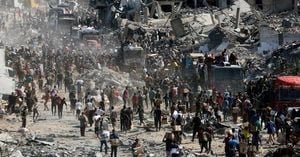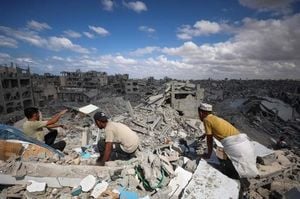Authorities are scrambling to address a potential danger at the Medizinische Hochschule Hannover (MHH) after the discovery of what is suspected to be World War II-era unexploded ordnance. On the morning of November 30, around 9,000 residents living within 1,000 meters of the campus were ordered to evacuate their homes as emergency services prepared for the evacuation and the bomb disposal operation.
The suspected unexploded bomb, referred to colloquially as a "blindgänger," was located at the construction site of the new medical facility. The alarm bell was rung after officials found indications of old munitions during initial assessments. Fire department representatives stated the situation warranted immediate action, leading to the planned evacuation.
Authorities were able to maintain order during the evacuation, with information disseminated to residents concerning which streets were affected. While some residents awaited news about their homes, others were escorted to safety by emergency services, ensuring access to transport services, including free buses.
During this period of uncertainty, the city of Hannover established multiple support centers for those displaced, including shelters at local schools. Approximately 500 people sought safety there, following guidelines set up by the authorities. A dedicated telephone hotline was also set up for residents with questions about the situation.
The operations planned on MHH grounds include comprehensive assessments for potential bomb remnants, which are not uncommon across Germany as remnants of the war frequently surface. City officials indicated they had narrowed down two areas of concern, but one of those had already been cleared. Further investigations will determine which areas may still pose risks.
While the evacuation exerted considerable stress on local residents, experts assured them there would be no immediate threat to the hospital's current patients. To facilitate safe operations, the MHH had implemented protective measures around the facility. This included temporary barriers to shield patients who required urgent care during the operation.
Michael Fantini, medical director of several nearby healthcare facilities, confirmed arrangements had been made to accommodate potential increase in patient volume from the MHH. "We expect to see more patients from MHH, and we have prepared by increasing our personnel," he shared.
Despite the challenges facing residents and personnel, the operation proceeded smoothly, with fire department officials optimistic they could secure the area earlier than anticipated. The city's integration of emergency services with public transport allowed for efficient movement of those needing to evacuate.
The response team, which included bomb disposal experts, focused on ensuring the safety of the community at large. Disruptions to air and rail traffic were adjusted accordingly, but the city sought to minimize impact on daily transportation routines wherever possible.
Throughout the day, reports from the site were closely monitored and shared with various local news agencies. Residents were encouraged to stay informed via city announcements and the provided emergency contact numbers.
By evening, city officials planned to lift the evacuation if the assessment yielded favorable results, allowing residents to return to their homes. Future plans for the MHH construction site will depend heavily on the findings of these bomb disposal operations.
Overall, the community rallied during this challenging day, demonstrating resilience and teamwork as they faced the uncertainties of the situation.



